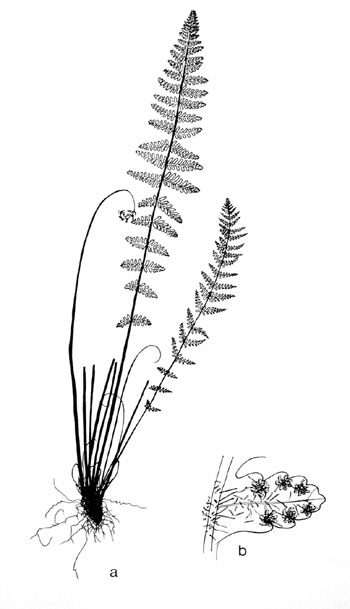|
Hardy Fern Home W. scopulina resources
All Ferns � Woodsiaceae �� Woodsia
�Other Genera
|
| Woodsia scopulina | ||
Mountain cliff fern | ||
|
Etymology
Scopulina is from the Greek, skopelos meaning peak, headland, or promontory.
Description
Rhizome: erect, scales brown, uniform and others with a dark central stripe.
Frond: 30 cm high by 5 cm wide, deciduous, monomorphic, blade/stipe ratio: 2:1. Stipe: shiny, chestnut-brown, persistent bases of unequal lengths, scales tan, vascular bundles: 2, round or oblong. Blade: 2-pinnate, but showing a great deal of variation, from not quite 2-pinnate to distinctly more, rhombic, tapering to both ends, truncated at base, herbaceous, gray-green, glands and sparsely hairy on both surfaces, rachis, costa with glandular hairs and scattered, white, jointed, hair-like scales. Pinnae: 10 to 15 pair, lowest distinctly reduced, sessile or nearly so, pairs further apart the closer to the base; costae grooved above, grooves continuous from rachis to costae; margins dentate or lobed; veins free, simple or forked, ending before the margin. Sori: round, near the margin, indusium: strap-like lobes encircling sorus, fraying at the tips, marginal hairs, basal, surrounding, sporangia: brown then black. Culture
Habitat: rock crevices, talus, ledges.
Distribution: western North America, scattered disjunct stations elsewhere in central, eastern N. A..
Hardy to -25�C, USDA Zone 5.
Distinctive Characteristics
Look at the synonyms to see how the experts get confused. The unjointed
stipe and the 2-pinnate division separates this from all but Ww. obtusa and oregona.
The glossy chestnut-brown stipe and rachis here is diagnostic as is the
white, jointed hair or hair-like scales on the lower surface of the
axes and blade.
Synonyms
Woodsia obtusa (Sprengel) Torrey var. lyallii Hooker Woodsia oregana D. C. Eaton var. lyallii (Hooker) Boivin |
|
|
Notes
Subtaxa Three subspecies are differentiated on the basis of characters not likely visible to the unaided eye.
Subtaxa Three subspecies are differentiated on the basis of characters not likely visible to the unaided eye.

Woodsia scopulina. Here the varied old stipe base lengths are evident in contrast to the other illustration. �Illustration by Edgar Paulton, from How to Know the Ferns and Fern Allies, John T. Mickel, � 1979 Wm. C. Brown Co. |
